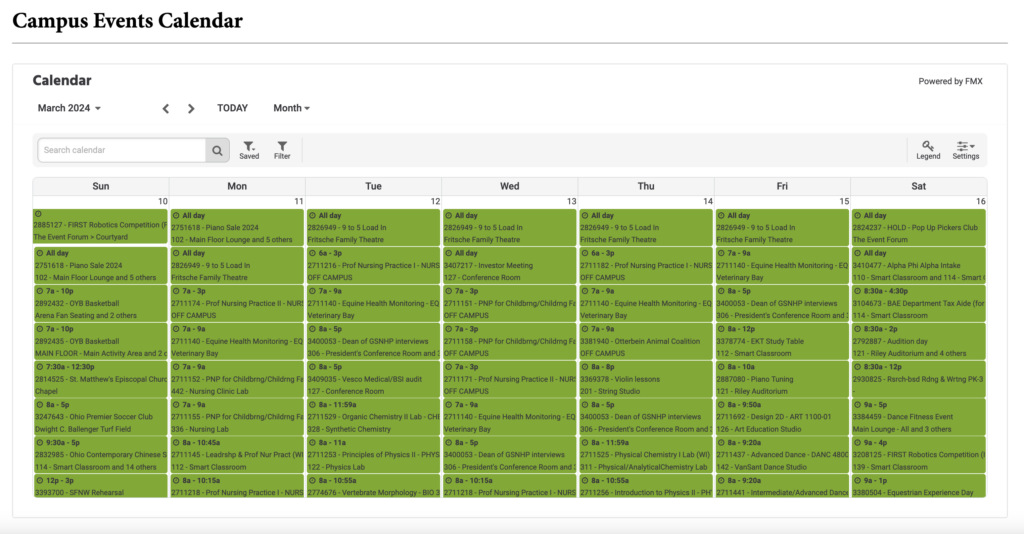Key takeaways you will find in this article
- •Student retention in higher education is critical for institutions
- •Retaining students is more cost-effective than recruiting new students
- •Research highlights a strong correlation between student engagement and academic achievement, which leads to higher retention rates
- •Facilities management platforms allow institutions to improve campus maintenance, creating an engaging college experience, and boosting retention rates
Table of contents
- Why is student retention in higher education important?
- Strategies to improve college student retention rate
- Strategies for fostering student engagement
- The role of early intervention in student retention in higher education
- Personalization: tailoring support for individual success
- Building a strong support system for student success
- Harnessing the power of data and feedback for a student retention strategy
- Addressing financial resources as a retention strategy
- Enhancing student support with FMX
Student retention in higher education is operationally critical for colleges. It is a pivotal measure of an institution’s success, reflecting its ability to support its student body.
High dropout rates present a multifaceted problem, affecting more than the financial stability of a university. They also impact their reputation and students’ academic outcomes.
Leading university officials explore effective retention strategies to improve student satisfaction to thrive in an increasingly competitive educational landscape.
Why is student retention in higher education important?
Universities that excel in retaining students safeguard their revenue streams and enhance their reputation and ability to attract future students.
Economic implications for students and universities
Students who remain enrolled are more likely to graduate, thereby avoiding the financial pitfalls of accruing debt without earning a degree. For universities, retaining students is more cost-effective than recruiting new ones.
The societal benefits of higher retention rates
High retention rates contribute to a more educated workforce, which is vital for economic development and innovation.
Communities benefit from lower unemployment and poverty levels. When more students graduate from college, these statistics drop and give community members higher earning potential.
Strategies to improve college student retention rate
Strategies to improve student retention include efficient campus maintenance, robust student financial aid, effective academic advising, and comprehensive support services tailored to individual student needs.
Creating a well-manicured and maintained campus encourages students to enroll and progress toward graduation.
Subscribe to monthly insights for facilities leaders
Be the first to know about new tips, best practices, procedures, templates, and digital tools from our facilities experts.
"*" indicates required fields
Campus maintenance matters for student retention
Campus aesthetics and facility conditions are often overlooked student retention factors. The Environmental Protection Agency (EPA) cites poorly maintained facilities as a driver of lower academic performance.
University maintenance departments must perform timely facility service. Due to the size of a typical college campus, effective building departments implement a systemic approach to stay organized and complete work orders as they arise.
Technological applications help employees receive needed resources and perform preventive maintenance of campus facilities, which can make a huge difference in student retention.
According to Pete Zuraw, vice president of marketing strategy and development at Gordian, “the relationship between the lack of investment in facilities and not just satisfaction but performance—performance in the classroom, performance of research. That translates into the ability of institutions to attract and retain students, not just bring them in.”
The power of engagement for strategies in student retention
Research highlights a strong correlation between student engagement and academic achievement.
Engaged students display higher levels of comprehension, critical thinking, and problem-solving skills, leading to better grades and academic success, which boosts retention.
Strategies for fostering student engagement
Effective strategies to enhance student engagement include creating a supportive and vibrant learning environment.
Leading universities integrate technology and active learning methodologies to make academics interactive and engaging.
Differentiate instruction tailored to meet individual student needs can significantly increase engagement by catering to diverse learning styles and preferences.
Active learning methodologies
Hands-on activities, group discussions, and problem-solving exercises encourage students to engage. This approach enhances learning outcomes and fosters collaboration among students.
These lecture types are better suited for well-maintained facilities. Holding classes in buildings with significant maintenance backlogs can undermine engagement initiatives. Staff must have access to the resources they need to complete upkeep.
How well is your facility operating?
Get feedback on the health of your facility’s operations by taking this short diagnostic survey.
Student involvement in extracurricular activities
Participation in clubs, sports, and other activities can enrich the student experience, promoting a sense of belonging and increasing the student retention rate.
These activities develop leadership skills, explore interests, and build networks. Facilities software allows students and employees to schedule space on campus to host club and extracurricular events, practices, and sponsored activities seamlessly.
Colleges often need a comprehensive system to manage campus spaces. Most have substantial buildings, conference rooms, lecture halls, classrooms, auditoriums, art galleries, and outdoor patios. Institutions need an event scheduling system to manage these spaces effectively and allow students to create engaging events there.
With facilities software, students can submit event requests, meaning groups, leaders, faculty members, and admins can submit event details to reserve spaces.
Many leading platforms offer configurable request forms. This allows different teams to respond if an event needs food service, AV assistance, or other critical details.

Building a sense of community on campus
Creating a strong sense of community on campus is crucial for a college’s student retention rate. A welcoming and inclusive campus environment can significantly impact their enrollment decision.
Efforts to enhance campus life, such as regular events, workshops, and forums, can help foster a sense of belonging among students.
It’s essential that colleges publish a digital calendar to increase event awareness and participation. Many comprehensive facilities management solutions offer a centralized view, allowing easy promotion. This enables students to access information about events from anywhere.
The role of early intervention in student retention in higher education
The United States sees around a 40% college dropout rate. Cost, emotional stress, and family responsibilities impact college retention rates. These students require targeted support to prevent stop-outs and dropouts.
Importance of identifying and addressing issues proactively
Proactively identifying and addressing issues before they escalate into reasons for leaving is essential.
Early Alert and Intervention Systems are instrumental in this process. Identifying at-risk students enables institutions to diagnose persistent roadblocks.
Proactive outreach programs
Proactive outreach programs play a crucial role in early intervention. By embedding support mechanisms into orientation procedures and other campus activities, institutions can preemptively address potential challenges, significantly improving retention outcomes.
Personalization: tailoring support for individual success
Students come from diverse backgrounds and experiences, making their needs unique. Recognizing diversity is the first step toward providing effective support.
By understanding and addressing individual needs, institutions can significantly improve student retention strategies in higher education.
Benefits of personalized academic and emotional support
Personalized support has a profound impact on both academic success and emotional well-being.
According to Salesforce.org, 69% of students who reported having a great educational experience stated that their institution offered personalized experiences tailored to their needs.
Flexible and accessible advising, which considers the student’s preferred communication channels and personal circumstances, increases student engagement and retention.
Implementing personalization in advising and mentorship
Continuous, proactive, personalized advising and mentoring experiences are critical for student retention.
Expanding career services to align with individual student goals can further personalize the support offered, making students feel prepared for their future careers.
Building a strong support system for student success
Students face challenges that can impact their academic journey. These include education costs, work and family responsibilities, academic requirements, and overcoming social and emotional hurdles.
Many students need remedial courses, which may not count toward their degree. This can lead to prolonged education paths and increased costs.
Comprehensive support services for academic and personal well-being
Leading institutions implement comprehensive support services informed by real-time data to address these challenges, guide decision-making, and tailor interventions.
Programs that offer high-intensity advising, coupled with financial assistance, show promising results.
Implementing flexible academic calendars, developing “meta-majors,” and involving industry leaders in professional degree tracks are among the best practices institutions are adopting to meet the diverse needs of their student populations.
Harnessing the power of data and feedback for a student retention strategy
Harnessing the power of data and feedback is crucial for developing effective student retention plans and improving retention in higher education.
The role of data-driven decision-making in retention efforts
Data-driven decision-making in higher education enables institutions to identify and understand the various factors impacting student retention and success.
When institutions analyze patterns in student data, they can forecast behaviors, such as the likelihood of a student continuing or discontinuing their studies, based on demographic, socioeconomic characteristics, academic performance, and engagement with the university culture.
This predictive capability allows for targeted interventions designed to support at-risk students effectively.
Gathering and utilizing feedback from students
Gathering and analyzing student feedback is essential for understanding their experiences and improving educational offerings. Feedback mechanisms can include direct surveys, interactive platforms, and engagement tracking through educational apps.
This feedback provides valuable insights into student satisfaction, engagement levels, and areas needing improvement.
When institutions address students’ specific needs and concerns, they can create a more supportive and engaging learning environment, contributing to higher retention rates.
Addressing financial resources as a retention strategy
Financial challenges are among the primary reasons students leave college before completing their degree.
Enhancing financial support can mitigate these challenges, giving students the stability they need to focus on their studies.
Overview of financial challenges faced by students
Students struggle with tuition, books, housing, and other educational expenses. These financial burdens can lead to stress and distraction, impacting academic performance.
Importance of financial aid and resources in graduation rates
Financial aid enables all students to access higher education, pursue their academic goals, and reduce the need to work excessive hours outside of class, which can detract from their studies.
Strategies for enhancing financial support
- Simplify the financial aid application process: Making it more accessible and less daunting encourages more students to apply for aid they are eligible for, potentially increasing retention rates.
- Target financial aid to students with the largest unmet needs: Directing aid to students who need it most can significantly impact retention. Research suggests retention is most positively impacted when aid is targeted to students at the lower income distribution.
- Tie financial aid to academic progress: Linking financial aid to academic benchmarks, such as GPA and class credits, incentivizes academic performance and progress, which can lead to an increase in the number of credits earned and improve retention rates.
These higher education retention strategies highlight the importance of a comprehensive approach. Addressing immediate financial needs and promoting behaviors that contribute to academic success and engagement is critical.
Enhancing student support with FMX
Creating an engaging university experience requires more than revamped financial or academic strategies. Leading universities also focus on hosting engaging events, improving campus aesthetics, and improving their facilities.
FMX offers colleges an all-in-one solution for managing campus facilities, empowering institutions to focus on what matters most: student success.
Interested in seeing how FMX can transform your institution’s student retention and facilities management approach?
Discover the difference firsthand. See how our solutions are right for your organization.
Written by
Zach Jones
Content Manager at FMX
